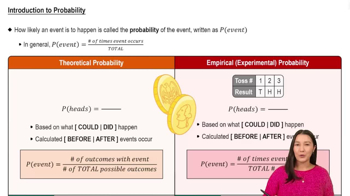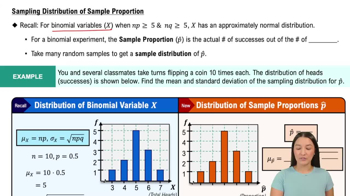2. Determine whether each number could represent the probability of an event. Explain your reasoning. c. 2.3
Table of contents
- 1. Intro to Stats and Collecting Data1h 14m
- 2. Describing Data with Tables and Graphs1h 55m
- 3. Describing Data Numerically2h 5m
- 4. Probability2h 16m
- 5. Binomial Distribution & Discrete Random Variables3h 6m
- 6. Normal Distribution and Continuous Random Variables2h 11m
- 7. Sampling Distributions & Confidence Intervals: Mean3h 23m
- Sampling Distribution of the Sample Mean and Central Limit Theorem19m
- Distribution of Sample Mean - Excel23m
- Introduction to Confidence Intervals15m
- Confidence Intervals for Population Mean1h 18m
- Determining the Minimum Sample Size Required12m
- Finding Probabilities and T Critical Values - Excel28m
- Confidence Intervals for Population Means - Excel25m
- 8. Sampling Distributions & Confidence Intervals: Proportion1h 25m
- 9. Hypothesis Testing for One Sample3h 29m
- 10. Hypothesis Testing for Two Samples4h 50m
- Two Proportions1h 13m
- Two Proportions Hypothesis Test - Excel28m
- Two Means - Unknown, Unequal Variance1h 3m
- Two Means - Unknown Variances Hypothesis Test - Excel12m
- Two Means - Unknown, Equal Variance15m
- Two Means - Unknown, Equal Variances Hypothesis Test - Excel9m
- Two Means - Known Variance12m
- Two Means - Sigma Known Hypothesis Test - Excel21m
- Two Means - Matched Pairs (Dependent Samples)42m
- Matched Pairs Hypothesis Test - Excel12m
- 11. Correlation1h 6m
- 12. Regression1h 50m
- 13. Chi-Square Tests & Goodness of Fit1h 57m
- 14. ANOVA1h 57m
4. Probability
Basic Concepts of Probability
Problem 3.1.11
Textbook Question
Matching Probabilities In Exercises 11-16, match the event with its probability.
a. 0.95
b. 0.005
c. 0.25
d. 0
e. 0.375
f. 0.5
11. A random number generator is used to select a number from 1 to 100. What is the probability of selecting the number 153?
 Verified step by step guidance
Verified step by step guidance1
Step 1: Understand the problem. The question asks for the probability of selecting the number 153 using a random number generator that selects numbers from 1 to 100. This involves understanding the concept of probability and the total possible outcomes.
Step 2: Recall the formula for probability. The probability of an event occurring is given by the formula: .
Step 3: Identify the favorable outcomes. In this case, the favorable outcome is selecting the number 153. However, note that the random number generator only selects numbers from 1 to 100, so 153 is not within the range of possible outcomes.
Step 4: Determine the total outcomes. The total number of outcomes is the range of numbers the generator can select, which is 100 (numbers 1 through 100).
Step 5: Conclude the probability. Since 153 is not within the range of possible outcomes, the probability of selecting 153 is 0. This corresponds to option 'd. 0' in the list of probabilities.
 Verified video answer for a similar problem:
Verified video answer for a similar problem:This video solution was recommended by our tutors as helpful for the problem above
Video duration:
1mPlay a video:
Was this helpful?
Key Concepts
Here are the essential concepts you must grasp in order to answer the question correctly.
Probability
Probability is a measure of the likelihood that a particular event will occur, expressed as a number between 0 and 1. A probability of 0 indicates an impossible event, while a probability of 1 indicates a certain event. In this context, understanding how to calculate the probability of selecting a specific number from a defined range is crucial.
Recommended video:

Introduction to Probability
Sample Space
The sample space is the set of all possible outcomes of a random experiment. For the random number generator selecting a number from 1 to 100, the sample space consists of the integers 1 through 100. Recognizing the sample space helps in determining the total number of outcomes when calculating probabilities.
Recommended video:

Sampling Distribution of Sample Proportion
Event
An event is a specific outcome or a set of outcomes from the sample space. In this case, the event is selecting the number 153. Since 153 is not included in the sample space of numbers from 1 to 100, understanding the distinction between events and outcomes is essential for accurately assessing the probability.
Recommended video:

Probability of Multiple Independent Events

 5:37m
5:37mWatch next
Master Introduction to Probability with a bite sized video explanation from Patrick
Start learningRelated Videos
Related Practice
Textbook Question
